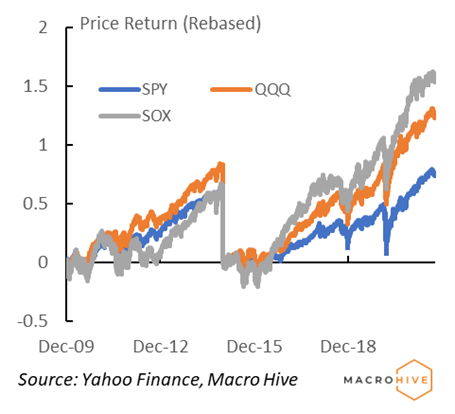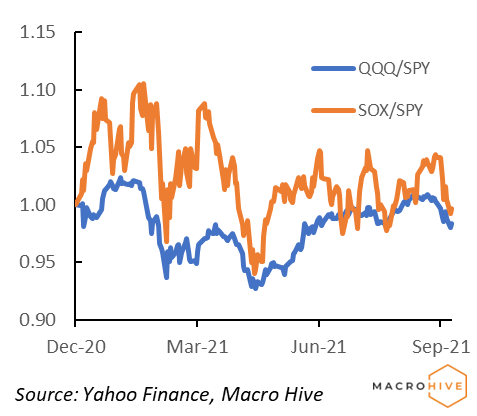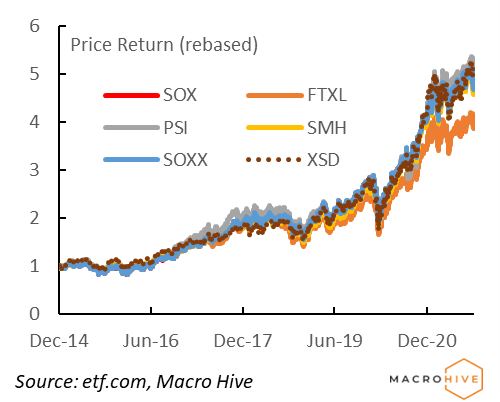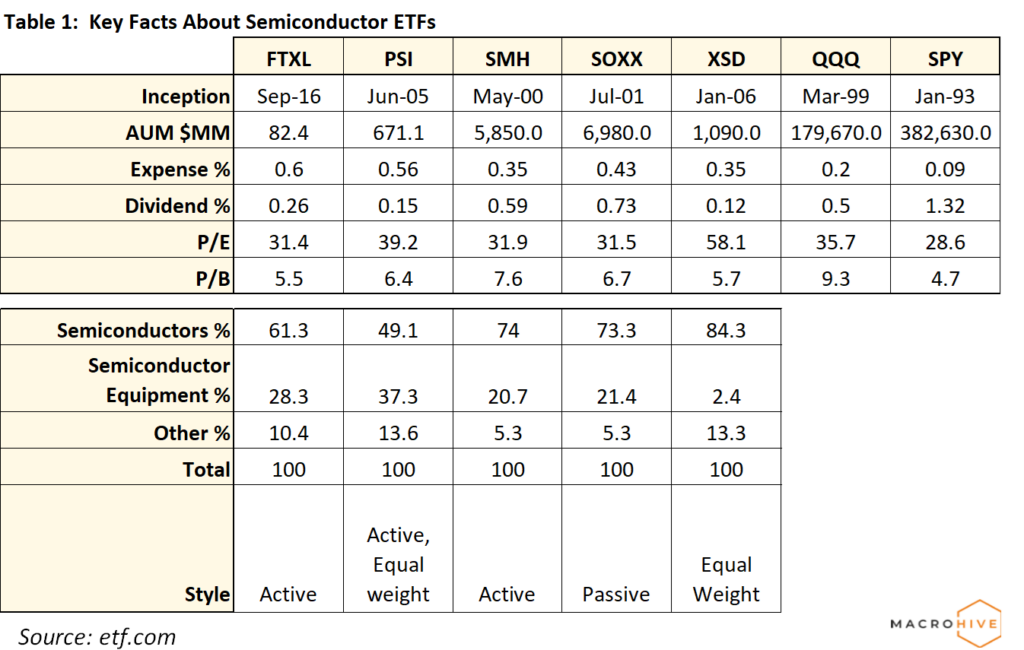

Summary
- One winning sector during the pandemic has been semiconductors.
- It benefited from sharply higher demand for consumer electronics, and network technology, such that the global economy (esp. the auto sector) faces a semiconductor shortage.
- For the first time in decades, the semiconductor industry is gaining pricing power.
- The ongoing shift to digital technology and the rise of electric vehicles all but guarantees strong demand and that pricing power will continue.
Investor Recommendation
- We recommend investors overweight semiconductor companies versus the broader tech sector or S&P 500.
- They can do this via the SOXX EFT versus QQQ (NASDAQ 100 ETF) or SPY (S&P 500 ETF).
- This is an intermediate-term macro trade. We acknowledge market technicals are soft, and some risk exists of a significant equity selloff in coming weeks or months. Should this occur, semiconductor stocks will underperform.
- Investors should scale their positions based on their views about these evolving technicals.
Semiconductors are the mechanical heart and brains of the digital age. Yet they are also something of a boom-and-bust industry, prone to shortages and followed by investment booms and overcapacity.
2021 has turned out to be a year of chip shortages. These have hamstrung the auto industry in particular as the pandemic spurred demand for a wide range of consumer electronic products.
Semiconductor manufacturers are gearing up again. Will past prove to be prologue? My colleague Phil Suttle argued convincingly last week that this time is indeed different. Some key points:
- For the first time in 30 years, quality-adjusted semiconductor prices are rising on heavy demand.
- Demand from the auto sector will only grow. Electric vehicles (EVs) require two to five times more semiconductors than regular cars. EV cars sales, now about 6% of global auto sales, are projected to rise to 24% by 2030.
- The internet-of-things market is projected to grow 25% annually in coming years. And the pandemic has spawned new demand for computers and networking equipment. A KPMG study concludes the pandemic has caused many companies to accelerate the move to cloud and automation technology by three to five years.
- Manufacturers will likely retreat from just-in-time inventory management systems and invest in larger inventories of key supplies such as semiconductors.
- Semiconductor manufacturers are increasing CAPEX to add capacity, but it will take several years before new chip foundries come online.
Geopolitical tensions are another factor that will drive semiconductor supply and demand. Today, 87% of semiconductor production capacity is in Asia. With the cost and risks of this exposure both apparent and rising, the US and Europe plan to invest in developing domestic foundry industries. This may lead to overcapacity at some point, but between the time it will take to build this capacity largely from scratch and the ongoing growth of digital technology, this day is some way off.
Are Semiconductors a Good Investment?
Underlying industrial fundamentals for semiconductors appear robust. But does that mean the semiconductor industry is a good investment now?
The primary index for the semiconductor sector is the Philadelphia Semiconductor Index, or PHLX SOX. It covers 30 semiconductor companies that trade in the US, either in stock or ADR form.
Over the past decade, it has experienced periods of rallying strongly, then tracking broader markets (Chart 1). After lagging following the Global Financial Crisis, SOX rallied strongly from 2013 through mid-2014, then again from early 2016 to mid-2007. It started another rally in 2019, but the pandemic cut that short. It resumed after the election, but has traded in a volatile range in 2021 (Chart 2). Currently, it is about flat with SPY (the large S&P 500 ETF) and modestly outperforming the NASDAQ 100 (QQQ). Given the ongoing publicity about semiconductor chip shortages and growing pricing pressure, this relatively weak performance is surprising.
Chart 1: Semiconductor Index Lags Then Surges
Chart 2: Tech is Flat to SPY in 2021


Clearly, markets are waiting to see how the semiconductor industry responds to shortages, and whether geopolitical issues outweigh underlying fundamentals.
From a macro and fundamental standpoint, being bearish on the semiconductor sector is difficult. We think another rally versus broader market indices is only a matter of time. That said, the risk lies more with short-term technicals. More analysts are calling for an equity market selloff between now and year end, although they are less forthcoming about the catalyst.
In our view, equities will not collapse of their own weight. Some external event must catalyse it – whether a debt ceiling crisis or an unexpected hawkish move by the Fed or other central bank. If an abrupt equity selloff strikes, semiconductor stocks will most likely underperform, providing an attractive opportunity to enter the sector.
We recommend investors start overweighting semiconductor stocks versus QQQ or SPY. This is an intermediate macro position. Investors should scale their overweight based on their views about near-term technicals.
Five ETFs track the semiconductor industry (Chart 3). Unsurprisingly, they mostly track the SOX and each other closely. Table 1 summarises key characteristics. SOXX is a passive ETF that matches the SOX. The other ETFs employ active management to try to outperform the index. XSD, for example, is also passive, but equally weighted so it favours the smaller growth companies. Their composition also varies slightly, with some holding other types of technology stocks with exposure to semiconductors.
Chart 3: Semiconductor ETFs Mostly Track SOX


Over a 30-year career as a sell side analyst, John covered the structured finance and credit markets before serving as a corporate market strategist. In recent years, he has moved into a global strategist role.
(The commentary contained in the above article does not constitute an offer or a solicitation, or a recommendation to implement or liquidate an investment or to carry out any other transaction. It should not be used as a basis for any investment decision or other decision. Any investment decision should be based on appropriate professional advice specific to your needs.)
